DSO Flexibility Market Framework for Renewable Energy Community of Nanogrids
Abstract
:1. Introduction
- Internal flexibility of the aggregation aimed at improving its energy efficiency by increasing the self-consumption. It represents an implementation of the Demand Side Management (DSM) concept where each member of the community is able to respond in order to achieve a reduction in its energy supply costs;
- External flexibility realized through the implementation of Demand Response (DR) activities, in which end users offer ancillary services to the network operators, i.e., DSO and Transmission System Operator (TSO), obtaining an accepted remuneration.
2. Starting Points
2.1. Smart-Net
- Centralized AS market model;
- Local AS market model;
- Shared Balancing Responsibility model;
- Common TSO-DSO AS market model;
- Integrated Flexibility market model.
2.1.1. Centralized AS market model (CS_A)
2.1.2. Local AS market model (CS_B)
2.1.3. Shared Balancing Responsibility model (CS_C)
2.1.4. Common TSO-DSO AS Market Model (CS_D)
2.1.5. Integrated Flexibility Market Model (CS_E)
2.1.6. Evaluation of the Coordination Models
2.2. Nodes
3. Nanogrid Renewable Energy Community Management
3.1. Market Entities and Involved Roles
3.2. Local Energy Market (LEM)
- -
- Reduction of the energy purchase price for consumers = PAP − PA.
- -
- Increase of the selling price for Producers = PA − PVP.
4. Interaction Model DSO-TSO
- TSO is only accountable for the real time physical balancing of the electricity system, so it is the manager of the related market. It manages the global ASM, where after a process of validation by the DSO, it can also procure flexibility resources connected to the distribution network.
- DSO procures ancillary services different from those aimed at frequency regulation (‘not-frequency’ services) in a local market; it defines the demand for local services to be supplied by DERs as well as the services to be activated when an emergency event occurs; it operates as a market facilitator and validator for the operations on the distribution network requested by the TSO; it operates in near real time with the aggregator to activate services offered by the resources connected to distribution networks.
- offers network services in aggregate form on the GLASM;
- selects among its users the resources to execute the orders, which derive from the offers accepted on the two market levels, first local and then global;
- in phase of selection of the units for offers on the ASM, the aggregator coordinates with the DSO to avoid problems on the network possibly caused by the activation of these resources connected to the distribution networks.
Flexibility Market in Distribution Network
- (1)
- control of the voltage profiles on the MV-LV busbars of the secondary substations;
- (2)
- current control on the MV and LV lines.
5. Operative Examples
5.1. Example of Ancillary Services Procurement
- -
- emergency conditions are detected in the HV network and there is a significant aggregation that can effectively contribute to resolve it without endangering the distribution network operations;
- -
- redistribution of DERs flexibility does not affect the first optimization more than a predetermined percentage threshold in terms of capacity or economic value.
5.2. Execution Methods of Services
- (1)
- The grid operator has all relevant information required for forecasting purposes (i.e., network constraints, load profiles, production forecasts).
- (2)
- The grid operator carries out forecasts regarding the state of the network, in particular for network sections in which the operator has identified a general flexibility need, using the information above mentioned (1).
- (3)
- Based on these forecasts, the network operator determines for each network section an associated color that represent the status. If the traffic light is in the green state (4) the forecasts of the network operator indicate that no adjustment of the expected load/injection is necessary. If the state of the traffic light is green, the retailer/aggregator controls the systems/resources that he manages according to the contract supply conditions. Generation plants can feed energy into the system freely for energy supply. Conversely, if the forecasts of the network operator indicate that there is a potential network constraints violation, then an adjustment of the expected load/injection in the network section is necessary. In this case, the operator activates the yellow phase of the traffic light for the corresponding network and submit a service request.
6. Conclusions
Author Contributions
Funding
Conflicts of Interest
References
- Directorate-General for Energy. Clean energy for all Europeans. Euroheat Power 2019, 14, 3. [Google Scholar] [CrossRef]
- Minniti, S.; Haque, N.; Nguyen, P.; Pemen, G. Local markets for flexibility trading: Key stages and enablers. Energies 2018, 11, 3074. [Google Scholar] [CrossRef] [Green Version]
- Brandeis, L.; Sprake, D.; Vagapov, Y.; Tun, H. Analysis of electrical energy storage technologies for future electric grids. In Proceedings of the 2016 IEEE NW Russian Young Researches in Electrical and Electronic Engineering Conference (EIConRusNW), Saint Petersburg, Russia, 2–3 February 2016; pp. 513–518. [Google Scholar] [CrossRef]
- Menniti, D.; Pinnarelli, A.; Sorrentino, N.; Burgio, A.; Brusco, G.; Frasca, V.; Mendicino, L.; Mercuri, M. Nanogrids for Home Application in a Power Cloud framework. In Proceedings of the 2016 AEIT International Annual Conference (AEIT), Capri, Italy, 5–7 October 2016; pp. 1–6. [Google Scholar] [CrossRef]
- Burgio, A.; Menniti, D.; Motta, M.; Pinnarelli, A.; Sorrentino, N.; Vizza, P. A two-input dual active bridge converter for a smart user network using integrated power modules. In Proceedings of the 2015 IEEE PES Asia-Pacific Power Energy Engineering Conference (APPEEC), Brisbane, QLD, Australia, 15–18 November 2015; Volume 3, pp. 1–6. [Google Scholar]
- Nordman, B.; Christensen, K. DC Local Power Distribution with microgrids and nanogrids. In Proceedings of the 2015 IEEE 1st International Conference on DC Microgrids (ICDCM), Atlanta, GA, USA, 7–10 June 2015; pp. 199–204. [Google Scholar] [CrossRef]
- Barone, G.; Brusco, G.; Burgio, A.; Menniti, D.; Pinnarelli, A.; Sorrentino, N. A power management and control strategy with grid-ancillary services for a microgrid based on DC bus. Int. Rev. Electr. Eng. 2014, 9, 792–802. [Google Scholar] [CrossRef]
- Menniti, D.; Sorrentino, N.; Pinnarelli, A.; Burgio, A.; Motta, M. A compact nanogrid for home applications with a behaviour-tree-based central controller. Appl. Energy 2018, 225, 14–26. [Google Scholar] [CrossRef]
- Menniti, D.; Sorrentino, N.; Pinnarelli, A.; Mendicino, L.; Brusco, G.; Vizza, P. Management model of Nanogrid based Community Energy Storage. In Proceedings of the 2020 AEIT International Annual Conference (AEIT), Catania, Italy, 23–25 September 2020; pp. 1–6. [Google Scholar] [CrossRef]
- Home—Comesto. Available online: http://www.comesto.eu/ (accessed on 29 July 2020).
- E-Distribuzione. E-Distribuzione Capofila del Progetto ComESto per l’integrazione di Storage e Generazione Distribuita|E-distribuzione. 2019. Available online: https://www.e-distribuzione.it/archivio-news/2019/02/comesto--e-distribuzione-capofila-del-progetto-per-lintegrazione.html (accessed on 29 July 2020).
- Regulation (EU) 2019/ 943 of the European Parliament and of the Council—Of 5 June 2019—On the Internal Market for Electricity. Available online: https://eur-lex.europa.eu/legal-content/EN/TXT/PDF/?uri=CELEX:32019R0943&from=EN (accessed on 25 November 2020).
- Directive (EU) 2019/ 944 of the European Parliament and of the Council—Of 5 June 2019—On Common Rules for the Internal Market for Electricity and Amending Directive 2012/27/EU. 2019. Available online: https://eur-lex.europa.eu/legal-content/EN/TXT/?uri=CELEX%3A32019L0944 (accessed on 25 November 2020).
- Drayer, E.; Hegemann, J.; Lazarus, M.; Braun, M.; Caire, R. Agent-based distribution grid operation based on a traffic light concept. In Proceedings of the 23rd International Conference on Electricity Distribution, Lyon, France, 15–18 June 2015; pp. 15–18. [Google Scholar]
- Deutsch, T.; Einfalt, A.; Kupzog, F.; Ghaemi, S. Avoiding grid congestions with traffic light approach and the flexibility operator. In Proceedings of the CIRED Workshop, Rome, Italy, 11–12 June 2014; pp. 11–12. [Google Scholar]
- Willems, B.; Zhou, J. The Clean Energy Package and Demand Response: Setting Correct Incentives. Energies 2020, 13, 5672. [Google Scholar] [CrossRef]
- SmartNet—Integrating Renewable Energy in Transmission Networks. Available online: http://smartnet-project.eu/ (accessed on 25 November 2020).
- Gerard, H.; Puente, E.I.R.; Six, D. Coordination between transmission and distribution system operators in the electricity sector: A conceptual framework. Util. Policy 2018, 50, 40–48. [Google Scholar] [CrossRef]
- Migliavacca, G. Ricerca sul Sistema Energetico. Il Ruolo dei Distributori Elettrici Nella Rete del Futuro. Quotid. Energia 2019, 1–5. Available online: https://www.quotidianoenergia.it/module/news/page/entry/id/438667 (accessed on 15 October 2019).
- ARERA 322/2019/R/EEL, Testo Integrato del Dispacciamento Elettrico. 2019. Available online: https://www.arera.it/it/docs/19/322-19.htm (accessed on 4 November 2019).
- Nodes. NODES Market-Design White Paper. 2018. Available online: https://nodesmarket.com/publications/ (accessed on 20 April 2019).
- Zupančić, J.; Prislan, B.; Lakić, E.; Medved, T.; Gubina, A.F.; Tuerk, A.; Kulmer, V. Market-based business model for flexible energy aggregators in distribution networks. In Proceedings of the 14th International Conference on the European Energy Market (EEM), Dresden, Germany, 6–9 June 2017. [Google Scholar] [CrossRef]
- Mendicino, L.; Menniti, D.; Pinnarelli, A.; Sorrentino, N. Corporate power purchase agreement: Formulation of the related levelized cost of energy and its application to a real life case study. Appl. Energy 2019, 253, 113577. [Google Scholar] [CrossRef]
- ARERA. Regolazione Delle Partite Economiche Relative All’energia Elettrica Condivisa da un Gruppo di Autoconsumatori di Energia Rinnovabile Che Agiscono Collettivamente in Edifici e Condomini Oppure Condivisa in Una Comunità. 2020. Available online: https://www.arera.it/allegati/docs/20/318-20alla.pdf (accessed on 17 December 2020).
- Commission Regulation (EU) 2015/1222—Of 24 July 2015—Establishing a Guideline on Capacity Allocation and Congestion Management. Available online: https://eur-lex.europa.eu/legal-content/EN/TXT/PDF/?uri=CELEX:32015R1222&from=IT (accessed on 25 November 2020).
- Commission Regulation (EU) 2017/2195—Of 23 November 2017—Establishing a Guideline on Electricity Balancing. Available online: https://eur-lex.europa.eu/legal-content/EN/TXT/?uri=CELEX%3A32017R2195 (accessed on 24 September 2019).

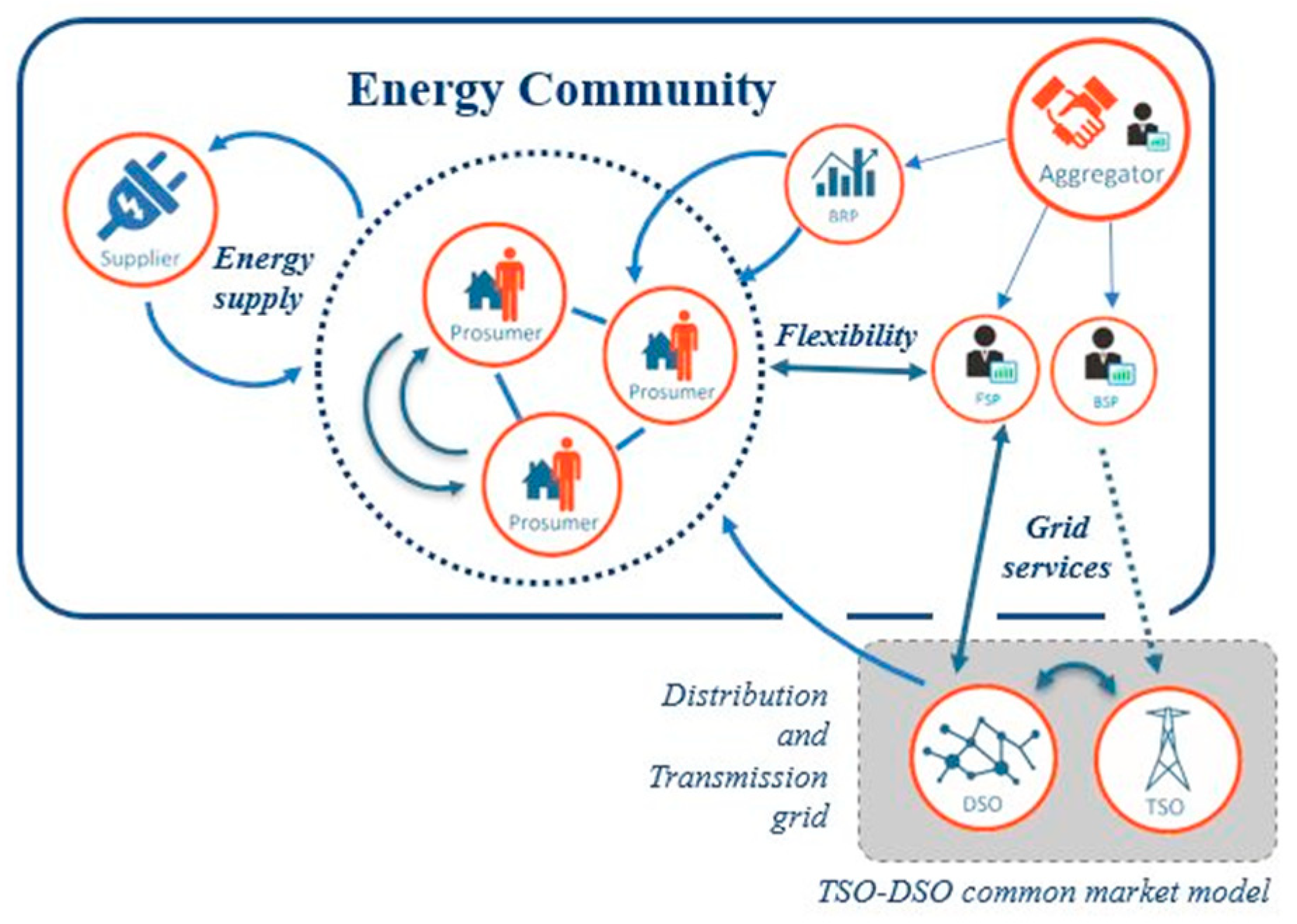
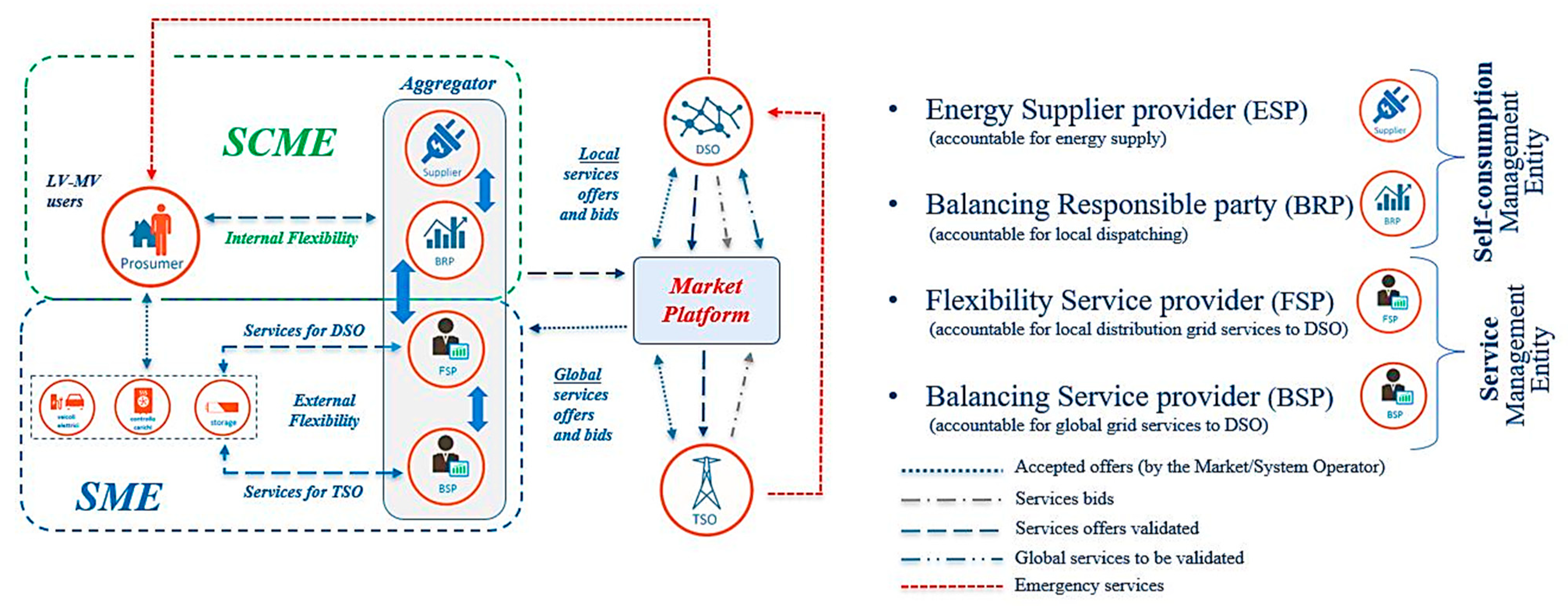
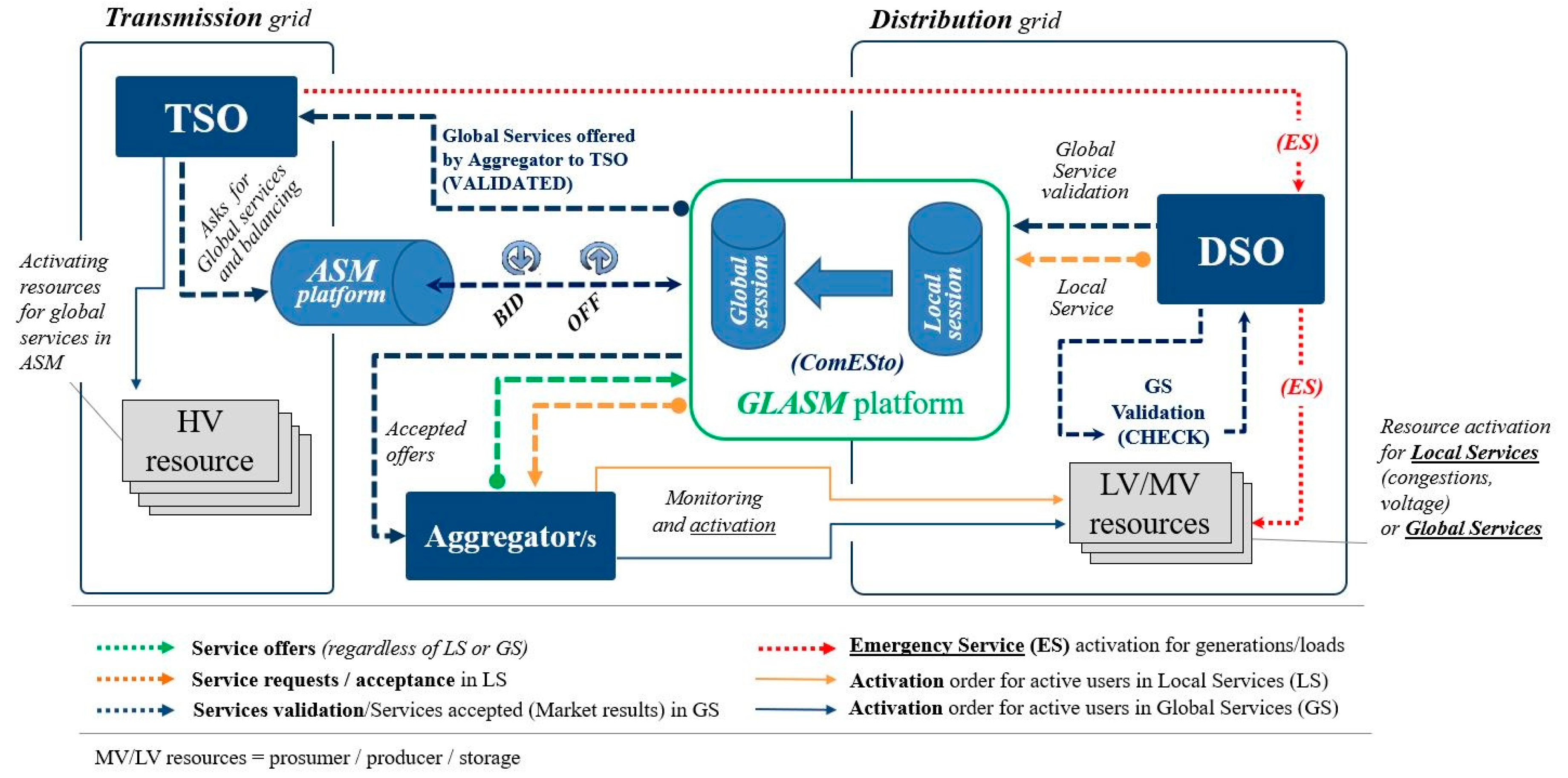
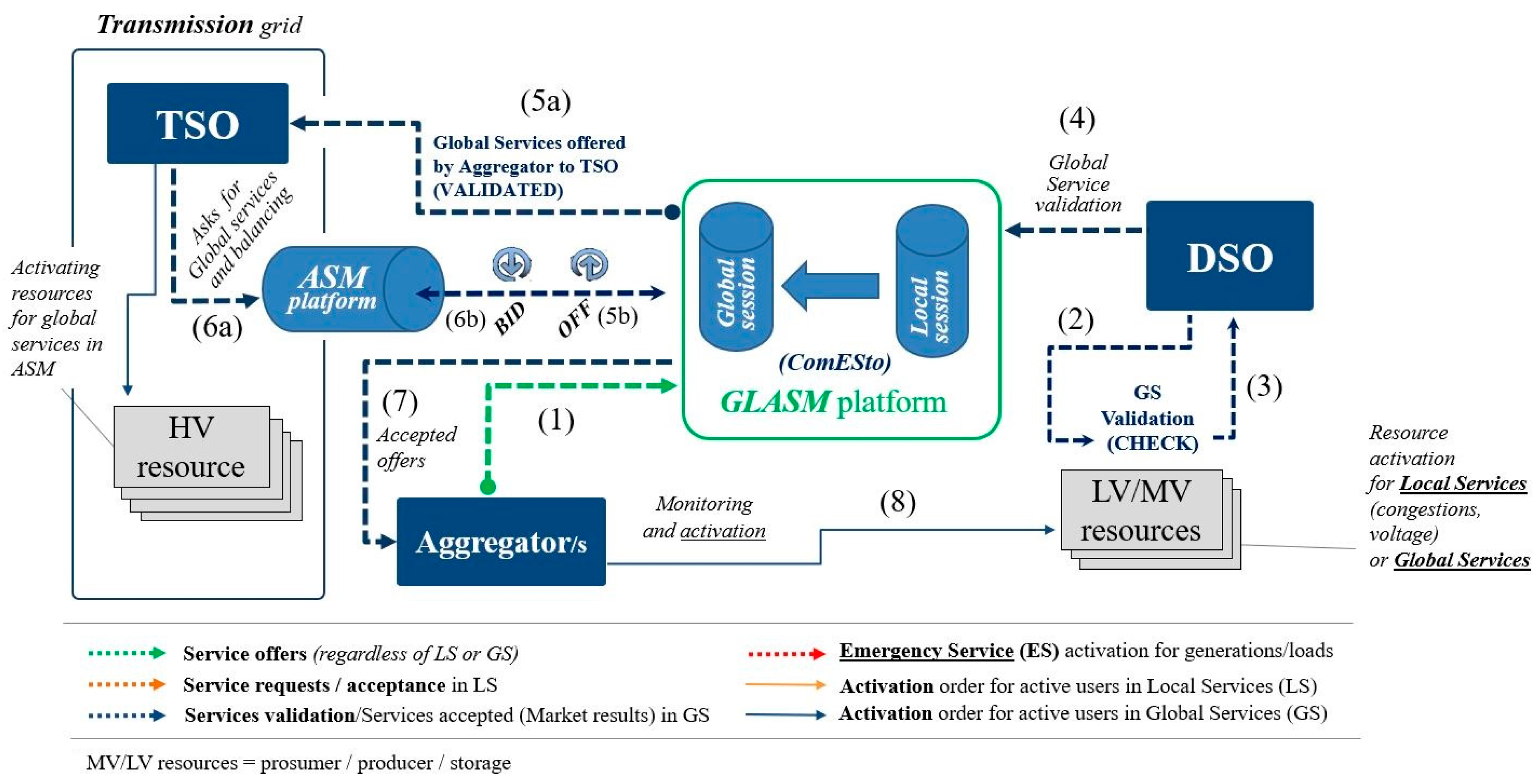
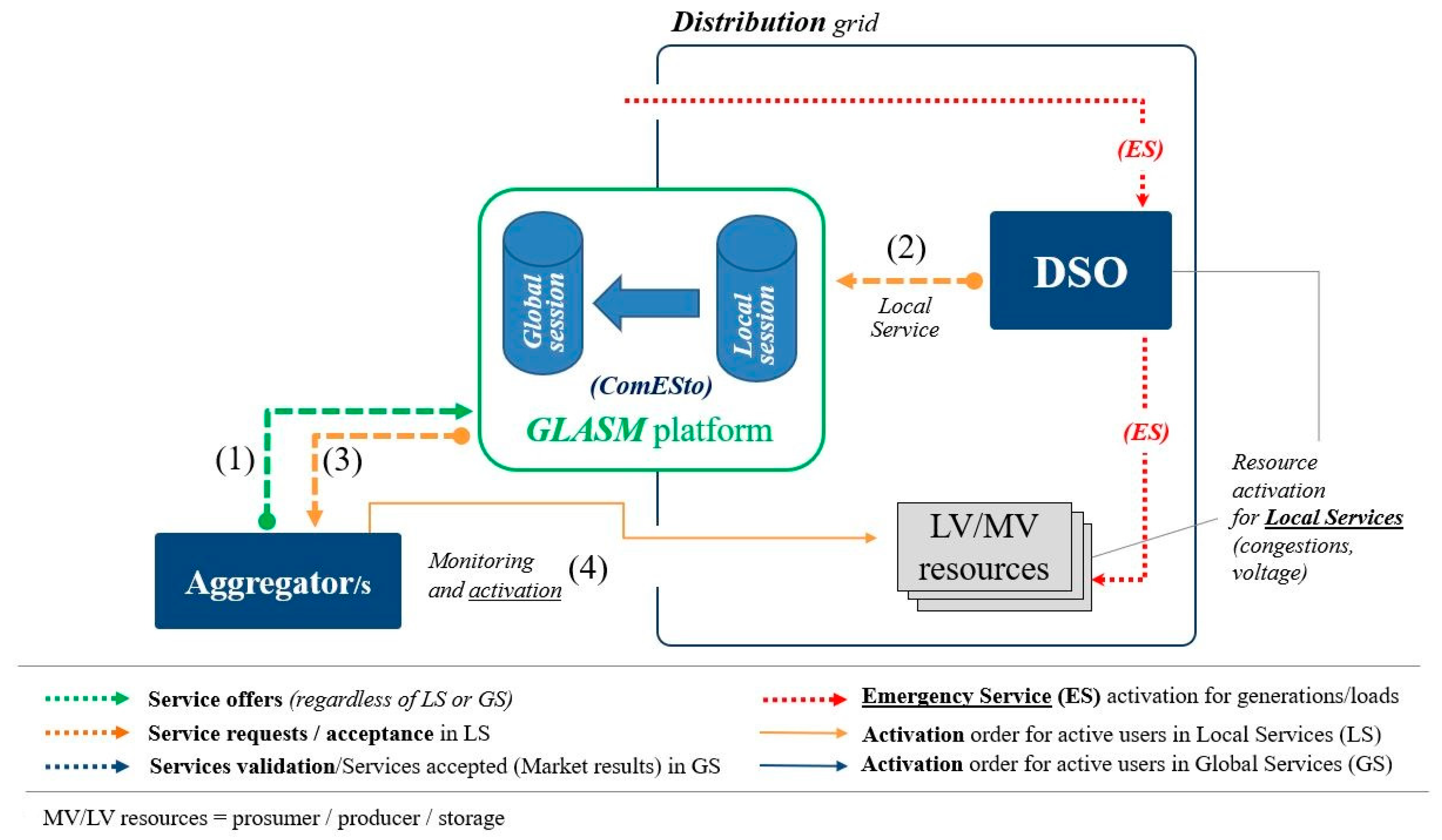
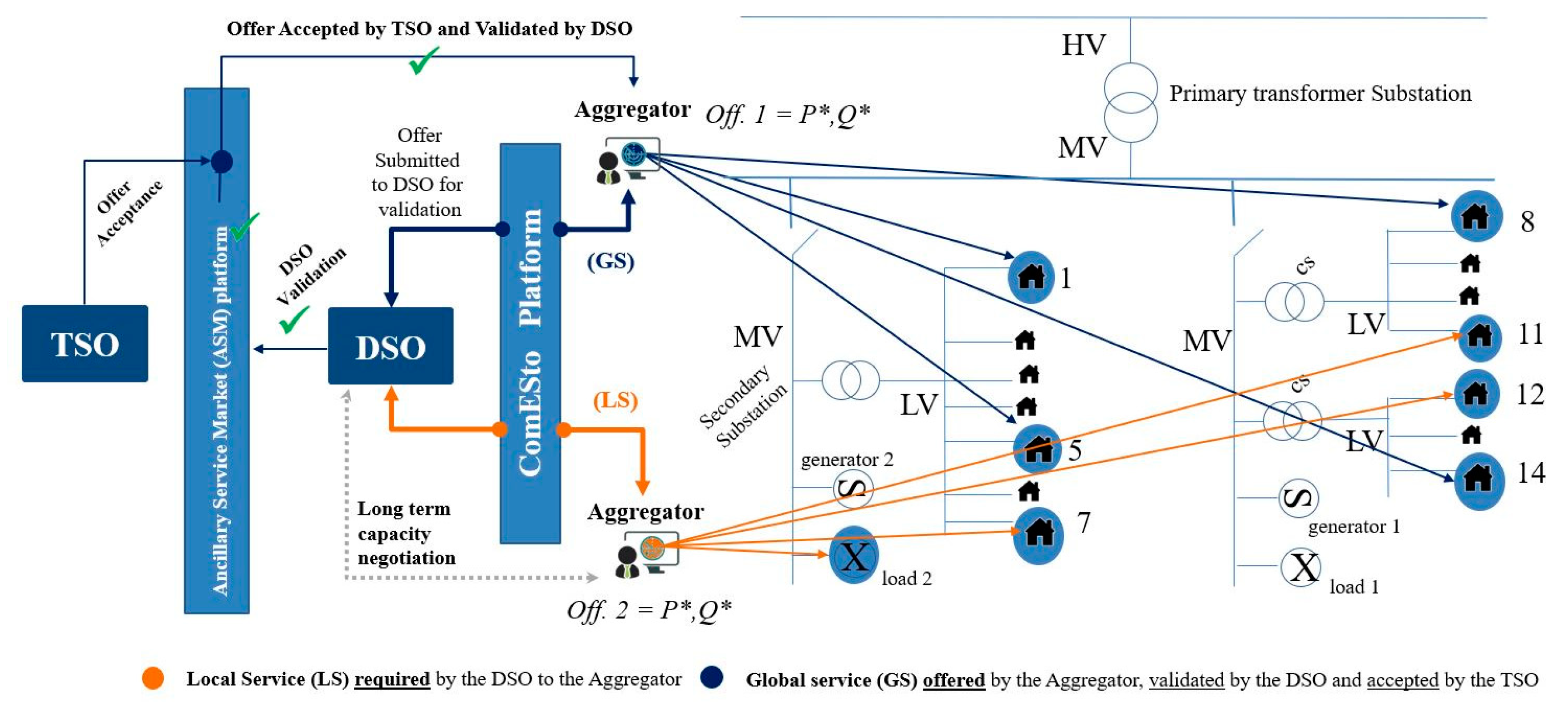
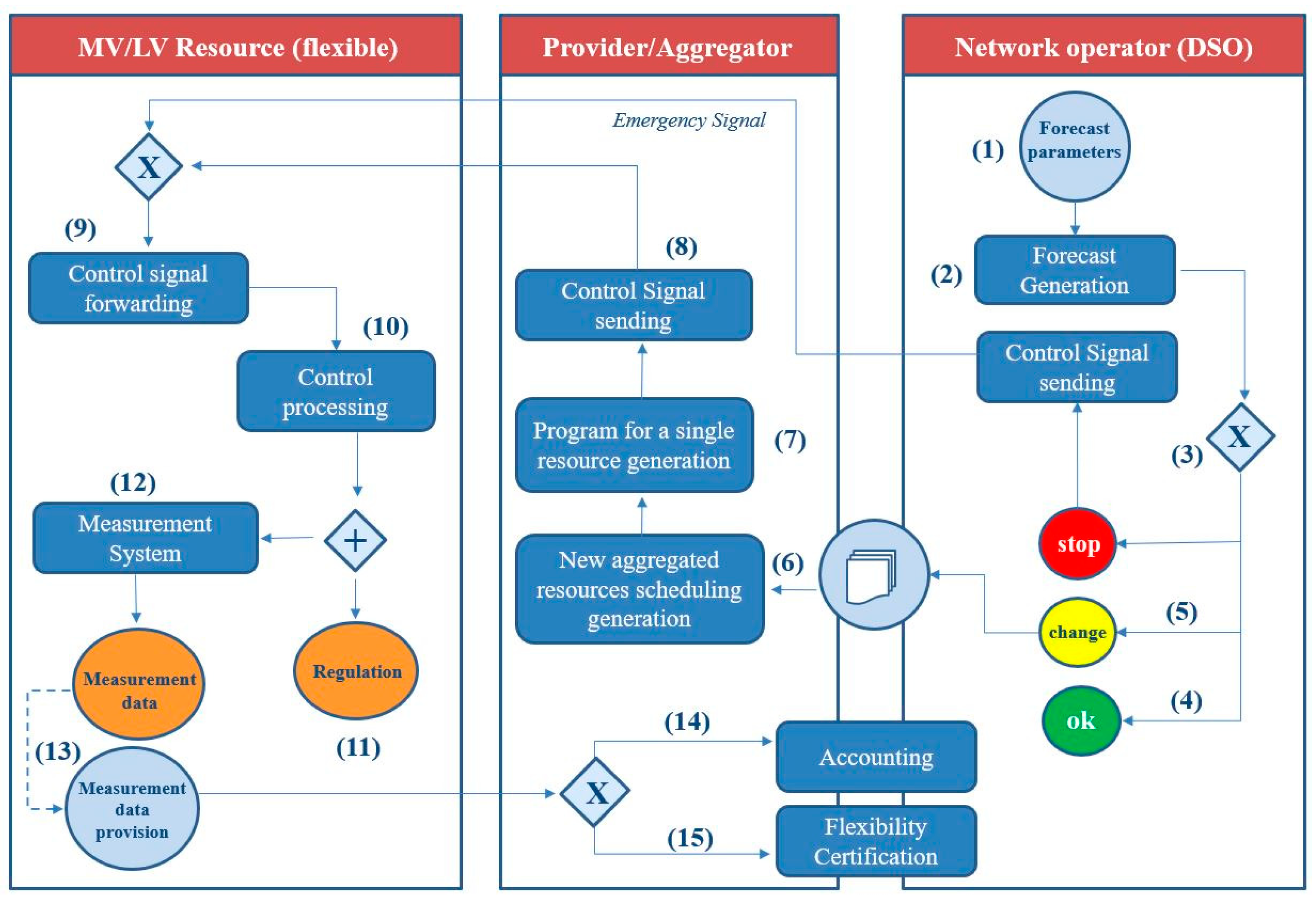
| Option A: High Powered Incentive Regulation for DSOs | ||
|---|---|---|
| Task/actors | Retail | Utility Co.–Retailer |
| Operating local grid | DSO | |
| Organizing local energy market; Procuring Local ancillary services | DSO | |
| Pro and cons | Pros |
|
| Cons |
| |
| Project (Country) | Use Case | Flexibility Domain | Involved Actors | Services | Market Model |
|---|---|---|---|---|---|
| SINTEG (DE) | C/sells: ALF | HV-LV | TSO, DSO | Congestions Resolution | yes |
| C/sells: ReFLEX | MV-LV | DSO | |||
| C/sells: Comax | MV-LV | TSO, DSO | |||
| WindNode | All voltage levels | TSO, DSO | |||
| Enera | All Voltage levels | TSO, DSO | |||
| New 4.0 | HV-MV | TSO, DSO | |||
| DA/RE Platform (DE) | - | MV-LV | TSO, DSO, BSP/BRP | Congestions Resolution | yes |
| NODES Market (EU) | - | All voltage levels | TSO, DSO, BSP, BRP | Congestions Resolution | yes |
| Grid Integration (DE) | - | MV-LV | DSO | Congestions Resolution | yes |
| GOPACS (NL) | - | HV-MV | TSO, DSO | Congestions Resolution | yes |
| Piclo-Flex Market (UK) | - | HV-LV | TSO, DSO | Congestions Resolution | yes |
| InterFLEX (EU) | DE UC 1–2 | LV | DSO | Congestions Resolution, power quality | no |
| DE UC 3 | LV | DSO | Ancillary services | no | |
| CZ UC 1–2 | MV-LV | DSO | DER integration | no | |
| CZ UC 3–4 | LV | DSO | Ancillary services | no | |
| NL UC 1–3 | MV-LV | DSO, Aggregator | Ancillary services, power quality | yes | |
| FR UC 1 | MV-LV | DSO, Aggregator | Automated islanded mode | no | |
| FR UC 3 | MV-LV | DSO, Aggregator | Congestions Resolution | yes | |
| Smart-Net | - | HV-LV | TSO, DSO | DER integration, Ancillary services | no |
| Equigy (IT) | - | MV-LV | TSO, Aggregator | Ancillary services | yes |
| Service | Contract Type | Description | |
|---|---|---|---|
| CONGESTION MANAGEMENT | 1-Congestion Management Capacity | (Multi) Year | In the planning phase, the DSO procures regulation capacity to manage potential congestions, ensuring compliance with the current limits on the branches and the voltage variation limits at the nodes. They are purchased at a ‘capacity price’. |
| 2-Congestion Management Real Time | Spot | It is purchased at the offered price (pay as bid) for all execution time intervals and aim to reduce the exploitation of the branches and/or the voltage variation at the nodes. Under the same technical and economic conditions, the resources previously reserved in capacity are selected as a priority. | |
| VOLTAGE CONTROL | 3-Voltage Control-Capacity Reactive Power | (Multi) Year | In the planning phase, the DSO procures regulation capacity of reactive power injection/absorption to maintain the grid voltage set point under normal operating conditions. It is purchased at a ‘capacity price’. |
| 4-Voltage Control-Real Time (activation of the related contracted services in capacity) | Spot | It is purchased at the offered price (pay as bid) for all execution time intervals to maintain the grid voltage set point under normal operating conditions. At the same technical and economic conditions, the resources previously reserved in capacity are selected as a priority. | |
| 5-Voltage Control Active Power-in emergency | Spot | Active power injection/absorption to maintain the grid voltage set point in emergency operating conditions. | |
Publisher’s Note: MDPI stays neutral with regard to jurisdictional claims in published maps and institutional affiliations. |
© 2021 by the authors. Licensee MDPI, Basel, Switzerland. This article is an open access article distributed under the terms and conditions of the Creative Commons Attribution (CC BY) license (https://creativecommons.org/licenses/by/4.0/).
Share and Cite
Mendicino, L.; Menniti, D.; Pinnarelli, A.; Sorrentino, N.; Vizza, P.; Alberti, C.; Dura, F. DSO Flexibility Market Framework for Renewable Energy Community of Nanogrids. Energies 2021, 14, 3460. https://doi.org/10.3390/en14123460
Mendicino L, Menniti D, Pinnarelli A, Sorrentino N, Vizza P, Alberti C, Dura F. DSO Flexibility Market Framework for Renewable Energy Community of Nanogrids. Energies. 2021; 14(12):3460. https://doi.org/10.3390/en14123460
Chicago/Turabian StyleMendicino, Luca, Daniele Menniti, Anna Pinnarelli, Nicola Sorrentino, Pasquale Vizza, Claudio Alberti, and Francesco Dura. 2021. "DSO Flexibility Market Framework for Renewable Energy Community of Nanogrids" Energies 14, no. 12: 3460. https://doi.org/10.3390/en14123460
APA StyleMendicino, L., Menniti, D., Pinnarelli, A., Sorrentino, N., Vizza, P., Alberti, C., & Dura, F. (2021). DSO Flexibility Market Framework for Renewable Energy Community of Nanogrids. Energies, 14(12), 3460. https://doi.org/10.3390/en14123460










